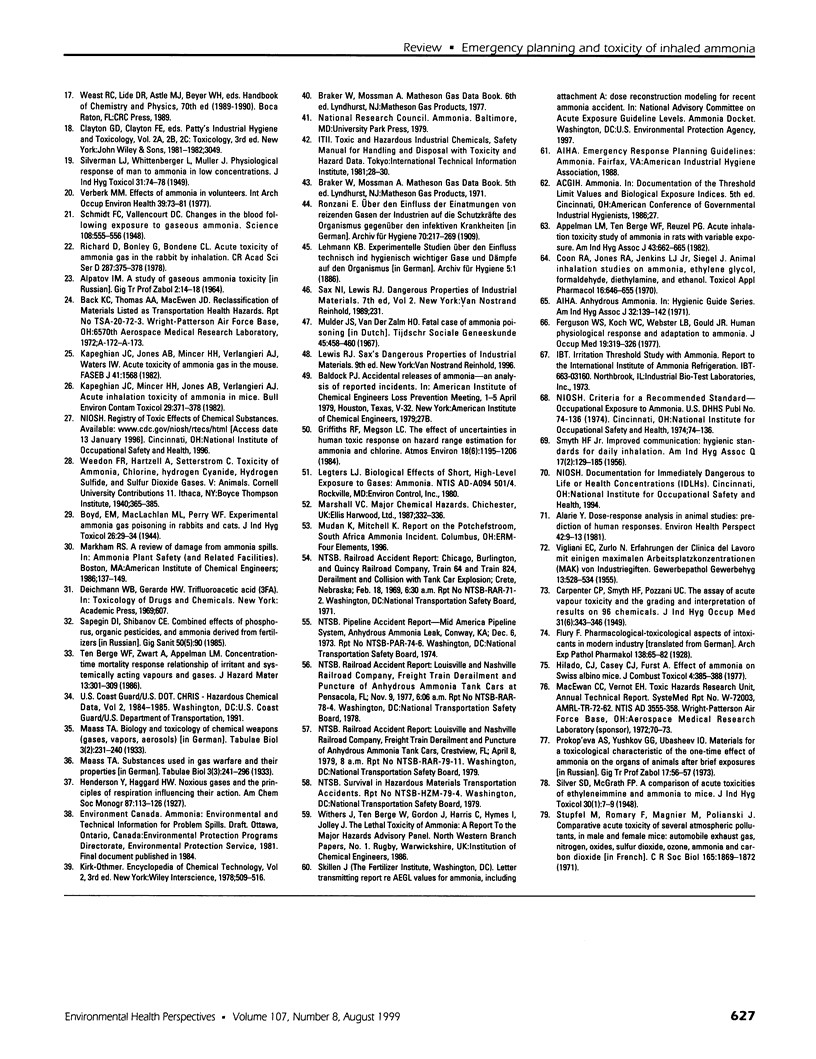Abstract
Ammonia is present in agriculture and commerce in many if not most communities. This report evaluates the toxic potency of ammonia, based on three types of data: anecdotal data, in some cases predating World War 1, reconstructions of contemporary industrial accidents, and animal bioassays. Standards and guidelines for human exposure have been driven largely by the anecdotal data, suggesting that ammonia at 5,000-10,000 parts per million, volume/volume (ppm-v), might be lethal within 5-10 min. However, contemporary accident reconstructions suggest that ammonia lethality requires higher concentrations. For example, 33,737 ppm-v was a 5-min zero-mortality value in a major ammonia release in 1973 in South Africa. Comparisons of secondary reports of ammonia lethality with original sources revealed discrepancies in contemporary sources, apparently resulting from failure to examine old documents or accurately translate foreign documents. The present investigation revealed that contemporary accident reconstructions yield ammonia lethality levels comparable to those in dozens of reports of animal bioassays, after adjustment of concentrations to human equivalent concentrations via U.S. Environmental Protection Agency (EPA) procedures. Ammonia levels potentially causing irreversible injury or impairing the ability of exposed people to escape from further exposure or from coincident perils similarly have been biased downwardly in contemporary sources. The EPA has identified ammonia as one of 366 extremely hazardous substances subject to community right-to-know provisions of the Superfund Act and emergency planning provisions of the Clean Air Act. The Clean Air Act defines emergency planning zones (EPZs) around industrial facilities exceeding a threshold quantity of ammonia on-site. This study suggests that EPZ areas around ammonia facilities can be reduced, thereby also reducing emergency planning costs, which will vary roughly with the EPZ radius squared.
Full text
PDF










Images in this article
Selected References
These references are in PubMed. This may not be the complete list of references from this article.
- ALPATOV I. M. IZUCHENIE TOKSICHNOSTI GAZOOBRAZNOGO AMMIAKA. Gig Tr Prof Zabol. 1964 Feb;8:14–18. [PubMed] [Google Scholar]
- Alarie Y. Dose-response analysis in animal studies: prediction of human responses. Environ Health Perspect. 1981 Dec;42:9–13. doi: 10.1289/ehp.81429. [DOI] [PMC free article] [PubMed] [Google Scholar]
- Amoore J. E., Hautala E. Odor as an aid to chemical safety: odor thresholds compared with threshold limit values and volatilities for 214 industrial chemicals in air and water dilution. J Appl Toxicol. 1983 Dec;3(6):272–290. doi: 10.1002/jat.2550030603. [DOI] [PubMed] [Google Scholar]
- Appelman L. M., ten Berge W. F., Reuzel P. G. Acute inhalation toxicity study of ammonia in rats with variable exposure periods. Am Ind Hyg Assoc J. 1982 Sep;43(9):662–665. doi: 10.1080/15298668291410387. [DOI] [PubMed] [Google Scholar]
- CARPENTER C. P., SMYTH H. F., Jr, POZZANI U. C. The assay of acute vapor toxicity, and the grading and interpretation of results on 96 chemical compounds. J Ind Hyg Toxicol. 1949 Nov;31(6):343–346. [PubMed] [Google Scholar]
- Coon R. A., Jones R. A., Jenkins L. J., Jr, Siegel J. Animal inhalation studies on ammonia, ethylene glycol, formaldehyde, dimethylamine, and ethanol. Toxicol Appl Pharmacol. 1970 May;16(3):646–655. doi: 10.1016/0041-008x(70)90069-4. [DOI] [PubMed] [Google Scholar]
- Ferguson W. S., Koch W. C., Webster L. B., Gould J. R. Human physiological response and adaption to ammonia. J Occup Med. 1977 May;19(5):319–326. [PubMed] [Google Scholar]
- Kapeghian J. C., Mincer H. H., Jones A. B., Verlangieri A. J., Waters I. W. Acute inhalation toxicity of ammonia in mice. Bull Environ Contam Toxicol. 1982 Sep;29(3):371–378. doi: 10.1007/BF01706243. [DOI] [PubMed] [Google Scholar]
- Richard D., Jouany J. M., Boudène C. Toxicité aiguë par voie aérienne du gaz ammoniac chez le Lapin. C R Acad Sci Hebd Seances Acad Sci D. 1978 Sep 11;287(4):375–378. [PubMed] [Google Scholar]
- Ruth J. H. Odor thresholds and irritation levels of several chemical substances: a review. Am Ind Hyg Assoc J. 1986 Mar;47(3):A142–A151. doi: 10.1080/15298668691389595. [DOI] [PubMed] [Google Scholar]
- SMYTH H. F., Jr Hygienic standards for daily inhalation. Am Ind Hyg Assoc Q. 1956 Jun;17(2):129–185. doi: 10.1080/00968205609344391. [DOI] [PubMed] [Google Scholar]
- Sapegin D. I., Shibanov S. E. Kombinirovannoe deistvie fosfororganicheskikh pestitsidov i ammiaka, vydeliaiushchegosia iz udobrenii. Gig Sanit. 1985 May;(5):90–92. [PubMed] [Google Scholar]
- Schmidt F. C., Vallencourt D. C. Changes in the Blood Following Exposure to Gaseous Ammonia. Science. 1948 Nov 19;108(2812):555–556. doi: 10.1126/science.108.2812.555. [DOI] [PubMed] [Google Scholar]
- Stupfel M., Romary F., Magnier M., Polianski J. Toxicité aiquü comparée, chez la souris mâle et femelle, de quelques polluants atmosphériques: gaz d'échappement de moteur d'automobile, oxydes d'azote, anhydride sulfureux, ozone, ammoniac et gaz carbinique. C R Seances Soc Biol Fil. 1971;165(9):1869–1872. [PubMed] [Google Scholar]
- Verberk M. M. Effects of ammonia in volunteers. Int Arch Occup Environ Health. 1977 Jun 30;39(2):73–81. doi: 10.1007/BF00380887. [DOI] [PubMed] [Google Scholar]




